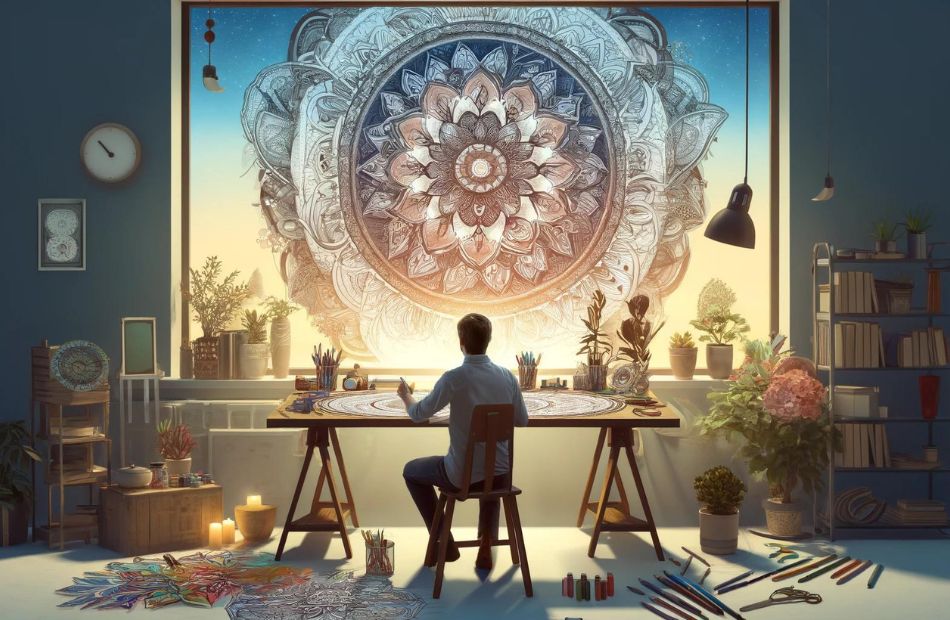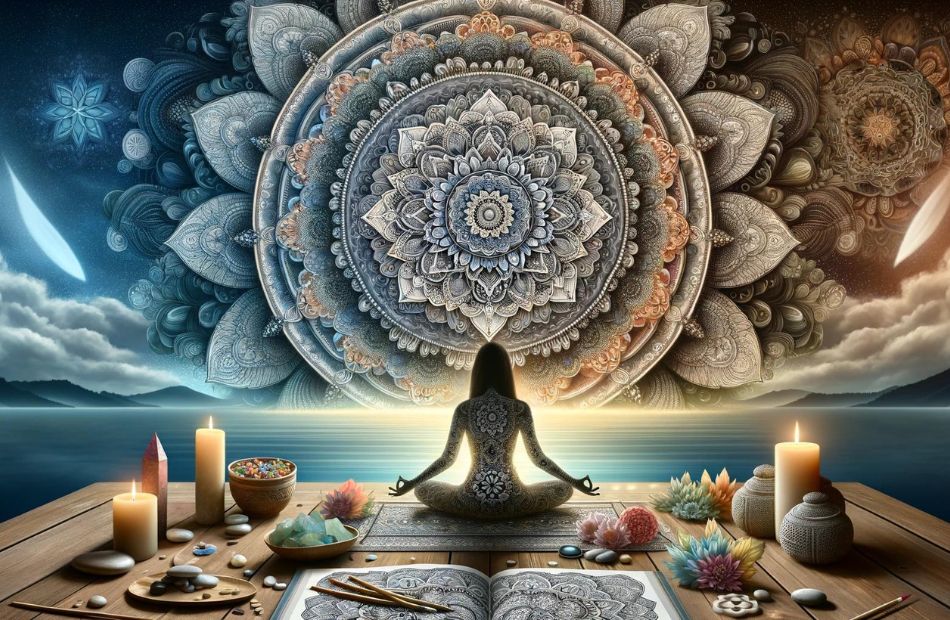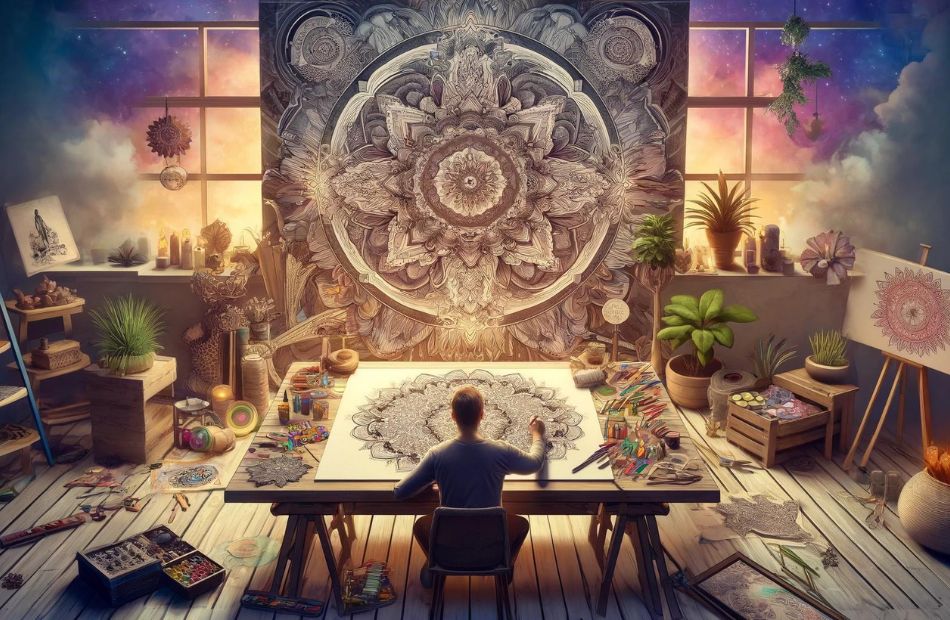Mindfulness? Hey there! Have you ever found yourself mesmerized by the intricate designs of a Mandala, or caught up in a moment of pure, blissful awareness where the world seems to pause? If you’ve nodded yes, or even if you’re just curious, you’re in for a treat. Today, we’re embarking on a fascinating journey exploring two profound concepts: mindfulness and Mandalas, and trust me, they go together like peanut butter and jelly.
Mindfulness: What’s the Buzz All About?
So, what is mindfulness? In a nutshell, it’s the art of being fully present and engaged in the moment, without letting our thoughts run off to the past or future. It’s about noticing the here and now, with a gentle, non-judgmental awareness. Imagine savoring each bite of your favorite chocolate, feeling its texture, and tasting its richness without any distractions. That’s mindfulness in action.
Originating from ancient Eastern traditions, mindfulness has made quite the splash in the modern world. And for good reasons! It’s like a Swiss Army knife for mental wellness, helping reduce stress, boost focus, and navigate our emotional seas with more grace. In our fast-paced, always-on culture, mindfulness is the pause button we often forget we have.
Mandalas: Not Just a Pretty Face
Now, let’s swirl our focus to Mandalas. These aren’t just random doodles or the latest trend in adult coloring books. Mandalas are deeply symbolic, intricate designs that have played a significant role in various cultures, especially within Buddhism and Hinduism. At their core, Mandalas represent the universe, but they’re also maps guiding us towards inner peace and enlightenment. Picture a circle filled with patterns and symbols; that’s your Mandala, a cosmic diagram that reminds us of our connection to the infinite.
Why They’re a Match Made in Mindfulness Heaven
You might be wondering, “What’s the connection between mindfulness and Mandalas?” Well, it’s quite magical. Mandalas are tools that can enhance our mindfulness practice, providing a focus for meditation that’s both grounding and uplifting. When we draw or color Mandalas, we’re not just filling in shapes; we’re taking a voyage inward, using the repetitive motion and concentration to anchor ourselves in the moment. It’s mindfulness in action, with a splash of creativity and color.
In this bustling world where our senses are constantly bombarded, Mandalas offer a sanctuary for the mind. They invite us to slow down, engage deeply with the present, and find a sense of calm and clarity amidst the chaos. And the best part? You don’t need to be an artist or a Zen master to dive in. Mandalas and mindfulness are accessible to everyone, ready to transform our experience of the world one moment, one color at a time.
So, are you ready to explore how these two ancient practices can bring a new dimension of peace and presence into your life? Let’s turn the page and discover the magic of Mandalas and mindfulness together.
Mandalas: A Deeper Dive into the Intricate World
Ever wonder about the story behind those mesmerizing, circular designs that seem to pull you in? Well, let’s dive into the fascinating world of Mandalas, a journey that’s as colorful and intricate as the designs themselves. Mandalas aren’t just art; they’re a whisper from ancient times, carrying secrets and wisdom from various cultures right into our modern lives.
Where It All Began
Mandalas have their roots deep in history, dating back thousands of years. Originating from the Sanskrit word meaning “circle,” Mandalas have been a spiritual and ritual symbol in Hinduism and Buddhism, representing the universe’s infinite nature. But it doesn’t stop there. Similar concepts can be found across cultures, each adding their own unique twist to what a Mandala represents. From the intricate sand Mandalas of Tibetan Buddhism to the rose windows of Gothic cathedrals, the essence of Mandalas transcends geographical and cultural boundaries, speaking a universal language of unity and harmony.
More Than Just Art
At first glance, Mandalas might just seem like complex geometric patterns. But there’s so much more beneath the surface. Each shape, line, and color in a Mandala holds meaning, from depicting philosophical ideas to symbolizing deep spiritual concepts like balance, eternity, and perfection. Mandalas serve as a tool for meditation, a focal point to help quiet the mind and achieve a state of deep contemplation and inner peace. The act of creating or coloring Mandalas can be a meditative journey, guiding the creator or observer from the chaos of the outer world to the calmness of the inner soul.
Mandalas Across Cultures
While we often associate Mandalas with Eastern religions, similar concepts echo around the world. In Native American traditions, the Medicine Wheel, a form of Mandala, is used for health and healing, embodying the elements, directions, and cycles of life. Even in Christianity, the labyrinth, a circular path leading to a center, offers a Mandalic journey towards spiritual enlightenment. It’s fascinating to see how different cultures have tapped into the power of the circle, each finding a path to spiritual understanding through geometry and design.
Why They Resonate Today
In today’s fast-paced, digital world, Mandalas offer a breath of fresh air, a moment of stillness in the storm. They remind us of the beauty of symmetry and the importance of balance, both externally and within. For many, creating or coloring Mandalas is a form of stress relief, a way to disconnect from the noise and reconnect with oneself. It’s a practice that doesn’t require any special skills or beliefs—just a willingness to explore and let the colors flow.
So, as we unravel the layers of Mandalas, we discover not just an art form but a bridge connecting us to the wisdom of the past, offering insights and tools for mindfulness that are as relevant today as they were centuries ago. Mandalas are a testament to the human spirit’s creativity and its endless quest for understanding, a circle that unites us all in its embrace. Let’s keep this journey going, exploring how Mandalas weave their magic into the practice of mindfulness, creating a tapestry of tranquility and awareness that enriches our lives.
The Science Behind Mandalas: Coloring Your Way to Calm

Have you ever found yourself completely absorbed in coloring a Mandala, so much that time seems to stand still, and your usual whirlwind of thoughts begins to quiet down? Well, there’s a fascinating blend of art and science at play here, making Mandalas and mindfulness a duo that packs a serious punch against stress.
The Brain on Mandalas
Let’s take a peek into what happens in our brains when we engage with Mandalas. Drawing or coloring these intricate designs can be a deeply meditative process, activating parts of our brain associated with attention and creativity, while dialing down the activity in areas linked to stress and anxiety. It’s like taking your brain to the gym, but instead of lifting weights, you’re lifting your mood and sharpening your focus.
Neuroscientists have found that the act of coloring can reduce activity in the amygdala, the brain’s alarm system responsible for our fight or flight response. This calming effect not only helps lower stress levels but can also improve our overall emotional well-being. Think of coloring a Mandala as a gentle, non-verbal way of telling your brain, “Hey, it’s okay to relax for a bit.”
Mandalas vs. Other Forms of Art
What sets Mandalas apart in the realm of mindfulness and stress relief? While all forms of creative expression can be beneficial, Mandalas have a unique edge due to their structure and symmetry. The circular nature of Mandalas and their repetitive patterns require a level of focus that other art forms might not. This concentration can lead us into a flow state, where our sense of time and self-consciousness evaporates, leaving a feeling of satisfaction and tranquility in its place.
Research has shown that coloring Mandalas can be more effective at reducing stress than free-form drawing or coloring. The contained beauty of a Mandala provides a framework that can be both comforting and liberating, allowing us to explore within its boundaries without feeling overwhelmed by endless possibilities.
The Color Connection
And let’s not forget about the role of color itself. The choices we make when coloring Mandalas can reflect our emotional state and influence our mood. Warm colors might stimulate and energize us, while cool colors can soothe and calm. This interplay of color and design adds another layer to the mindfulness practice, making each Mandala session a personal journey of discovery and expression.
Practical Magic
So, how can you tap into this mindful magic? It’s simpler than you might think. You don’t need fancy art supplies or hours of free time. Just a few minutes with a Mandala and some colors can make a noticeable difference in your day. It’s about giving yourself permission to pause, to engage in an act of creation that’s as beneficial for your brain as it is for your soul.
As we explore the science behind Mandalas and mindfulness, it becomes clear that this ancient practice has much to offer in our modern quest for calm and clarity. Whether you’re an experienced artist or someone who struggles to draw a straight line, Mandalas provide a space to connect with the moment, reduce stress, and rediscover the joy of creativity. So, why not grab some colors and see where the journey takes you? The path to peace might just be a Mandala away.
Engaging with Mandalas Mindfully: A Guide to Inner Peace

Have you ever considered that the simple act of coloring could be your gateway to mindfulness? Let’s dive into how engaging with Mandalas can become a mindful practice, transforming them from mere designs into tools for achieving inner peace and clarity.
Setting the Stage for Mindfulness
First things first, to truly engage with Mandalas mindfully, it’s essential to create an environment that encourages focus and calm. Find a quiet space where you can sit comfortably without interruptions. This could be a cozy corner of your home, a spot in your garden, or anywhere that you feel at ease. The idea is to make this space your mindfulness sanctuary, a place where the busyness of life takes a back seat.
Choosing Your Mandala and Colors
Picking the Mandala that you’ll be working with is a mindful practice in itself. Instead of randomly selecting one, take a moment to really look at the designs. Which one speaks to you today? Trust your intuition—it’s often drawn to what your mind needs. Similarly, when choosing colors, don’t overthink it. Let your mood guide your selection. The colors you’re drawn to are often reflective of your emotional state and can enhance the meditative experience.
Breathing Life into Your Mandala
As you begin to color, focus on your breath. Taking deep, slow breaths can help center your mind, making it easier to enter a state of mindfulness. With each stroke, be fully present. Notice the feel of the pencil or brush in your hand, the texture of the paper, and the way the colors blend together. If your mind starts to wander, gently bring your focus back to the coloring. This practice of returning your attention to the Mandala serves as a mindful exercise in itself, teaching you to anchor your thoughts in the present moment.
The Role of Intention
Before you start, set an intention for your coloring session. It could be as simple as seeking calm, expressing gratitude, or letting go of the day’s stress. This intention will infuse your coloring practice with purpose, transforming it from a mere activity to a meaningful ritual.
Incorporating Mandalas into Your Daily Routine
Mindful coloring doesn’t require hours of commitment. Even just a few minutes a day can make a significant difference in your stress levels and overall mood. Consider making it a daily ritual, perhaps as a way to unwind in the evening or to find focus at the start of your day. The key is consistency and allowing yourself this time free from judgment or expectation.
Mindfulness Beyond Coloring
Engaging with Mandalas can extend beyond coloring. You can also use completed Mandalas as objects of meditation, focusing on the design and letting it guide your contemplation. Displaying your Mandalas can serve as a reminder of your mindfulness practice, bringing a sense of peace and accomplishment to your space.
As we explore the intersection of Mandalas and mindfulness, it becomes clear that this ancient art form offers more than just aesthetic pleasure. It’s a pathway to understanding ourselves better, to grounding ourselves in the present, and to discovering the profound peace that lies within the act of creation. So, grab your Mandalas, set your intention, and let the journey to mindfulness begin.
Mandalas in the Digital Age: A New Dimension of Mindfulness

As we navigate the intersection of ancient practices and modern technology, Mandalas have gracefully transitioned into the digital realm, offering a new dimension of mindfulness accessible with just a tap or click. This fusion of tradition and innovation invites us to explore how Mandalas can enhance our mindfulness practice in today’s tech-driven world.
Virtual Mandalas: Mindfulness at Your Fingertips
Imagine creating or coloring Mandalas without the need for physical art supplies, accessible anytime and anywhere. Digital Mandalas, through apps and websites, make this possible. These platforms offer an array of tools that allow for a seamless coloring experience, complete with a vast palette of colors and various brush styles. The digital medium also introduces functionalities like undo buttons and zoom features, making the Mandalas experience more forgiving and adaptable to individual preferences.
The Benefits of Digital Mandalas
One might wonder, do digital Mandalas offer the same mindfulness benefits as their traditional counterparts? The answer is a resounding yes. The core of the practice—focusing on the present moment through the act of coloring—remains intact, regardless of the medium. Digital Mandalas offer convenience and accessibility, making it easier for people to incorporate mindfulness into their daily routines. For those with busy schedules or limited access to art supplies, digital Mandalas can be a gateway to regular mindfulness practice.
Interactive Mandalas and Virtual Reality
The digital age has also introduced interactive Mandalas and virtual reality (VR) experiences, taking the practice to unprecedented levels of immersion. Imagine donning a VR headset and stepping into a three-dimensional Mandala, where you can walk through intricate patterns and colors, experiencing mindfulness in a fully immersive environment. These experiences blur the lines between the creator and the creation, offering a unique way to engage with Mandalas and mindfulness.
Challenges and Considerations
While digital Mandalas offer new opportunities for mindfulness practice, they also come with considerations. The very technology that enables digital Mandalas can also be a source of distraction. Notifications, messages, and the lure of the internet can interrupt the mindfulness journey. Thus, setting intentions and boundaries around technology use during Mandala practice is crucial.
Additionally, for some, the tactile experience of coloring on paper with physical tools is an integral part of the mindfulness practice. The texture of the paper, the smell of the crayons or pencils, and the physical act of coloring can enhance the sensory experience, grounding the individual in the moment. For these practitioners, digital Mandalas might serve as a complement rather than a replacement for traditional coloring.
Embracing the Digital Journey with Mindfulness
As Mandalas continue to evolve in the digital age, they remind us of the timeless nature of mindfulness practice. Whether through a coloring book or a tablet screen, the essence of Mandalas—drawing our focus inward and fostering a state of calm—remains unchanged. By embracing digital Mandalas, we open ourselves to a world of possibilities, where mindfulness is not confined by time, space, or medium but is a constant companion in our journey towards inner peace. In this digital era, Mandalas stand as a bridge, connecting the ancient wisdom of mindfulness with the modern pace of life, inviting us to find tranquility in the here and now, one digital stroke at a time.
Crafting Your Own Mandalas for Mindfulness

Embarking on the journey of creating your own Mandalas is a deeply personal and enriching experience, blending creativity with mindfulness in a way that’s uniquely tailored to you. Whether you’re an experienced artist or someone who can barely draw a stick figure, the process of crafting your own Mandalas offers a special pathway to inner peace and self-discovery. Let’s explore how you can start this fulfilling journey.
Gathering Your Tools
First, let’s talk about what you’ll need. The beauty of making Mandalas is in its simplicity. Your basic toolkit could include:
- Paper: Anything from a sketchbook to loose sheets of your preferred size.
- Drawing tools: Pencils for sketching, fine liners or pens for defining, and markers or colored pencils for bringing your designs to life with color.
- Compass and ruler: Essential for creating perfect circles and symmetrical designs.
- A quiet, comfortable space where you can work undisturbed.
Remember, while the materials are important, your intention and presence during the creation process hold the real magic.
Starting Your Mandala
Creating a Mandala is as much about the process as it is about the outcome. Here’s a simple guide to begin:
- Center and Intention: Start by drawing a dot in the center of your paper. This dot represents both the physical and spiritual starting point of your Mandala. Take a moment to set an intention for your creation process.
- Drawing Circles: Using your compass, draw concentric circles out from the center. These serve as the foundational structure of your Mandala and symbolize the universe’s expansiveness.
- Segmentation: With a ruler, draw lines across your circles to segment them, creating a simple structure for your patterns. This can be as detailed or as sparse as you like.
- Patterns and Symbols: Begin filling in the segments with patterns, shapes, and symbols that resonate with you. There’s no right or wrong here; let your intuition guide you.
- Coloring: Once you’re happy with your design, bring it to life with color. Pay attention to how different colors make you feel and let your emotional landscape guide your choices.
Mindfulness in the Making
As you draw and color, remain mindful of each moment. Notice the feel of the paper, the sound of the pencil, the way the colors blend. If your mind wanders, gently bring your focus back to your Mandala. This practice is not just about creating a beautiful design but about finding stillness and awareness through the act of creation.
Beyond the Paper
Creating Mandalas can extend beyond traditional materials. Explore using natural elements, digital platforms, or even three-dimensional models. The key is to find a medium that speaks to you and enhances your mindfulness practice.
Sharing and Reflecting
Once completed, your Mandala serves as a reflection of your inner state during its creation. Take time to meditate on your finished piece, reflecting on your intention and the feelings it evokes. Sharing your Mandalas with others can also be a powerful way to connect, offering insights into your journey and inviting others to explore their own paths of mindfulness.
Crafting your own Mandalas is a journey that marries art and meditation, inviting you to explore the depths of your creativity and mindfulness. Each Mandala is a mirror, reflecting back the complexities and colors of your inner world. So, gather your tools, set your intention, and let the journey unfold, one circle, one pattern, one color at a time.
Mandalas for Children and Education: Coloring Inside and Outside the Lines

Introducing Mandalas into the world of children and education opens up a vibrant palette of possibilities for teaching mindfulness, focus, and self-expression. Far from being just an artistic activity, Mandalas can become a bridge to important life skills for children, making them an invaluable resource in both homes and classrooms.
The Magic of Mandalas for Young Minds
Children, with their innate curiosity and love for colors and patterns, are naturally drawn to Mandalas. These designs can serve as a fun and engaging way to introduce them to the concept of mindfulness. Coloring or creating Mandalas can help children learn to focus their attention, a skill that benefits them not just academically but in all aspects of life. It’s a gentle way to guide them toward being present, helping them to notice and enjoy the beauty of the moment.
Emotional Exploration Through Color
Mandalas also offer children a safe and accessible means to explore their emotions. The act of choosing colors and filling in designs allows them to express feelings they might not yet have the words to articulate. This can be particularly beneficial in educational settings, where emotional regulation is just as crucial as academic learning. Teachers and parents can use Mandalas as a tool to open conversations about emotions, encouraging children to share and understand their feelings more deeply.
Incorporating Mandalas into Educational Settings
Incorporating Mandalas into the curriculum can be as simple as having coloring sessions for younger children or more structured art projects for older students. Here are a few ideas:
- Mindful Mornings: Start the day with a quiet Mandalas coloring session, setting a calm and focused tone.
- Art Meets Science: Explore the geometry of Mandalas, integrating art with math lessons on shapes, symmetry, and patterns.
- Cultural Journeys: Use Mandalas to teach about different cultures and traditions, turning art lessons into global explorations.
- Emotional Literacy: Pair Mandalas coloring with discussions about emotions, using colors and patterns as a language for children to express their feelings.
Success Stories
Schools and programs that have integrated Mandalas into their routines report notable improvements in students’ attention spans, emotional well-being, and creativity. Teachers observe that Mandalas can act as a calming influence, reducing anxiety and improving overall classroom dynamics. Furthermore, children who regularly engage with Mandalas often show an increased interest in art and a greater capacity for mindfulness.
Mandalas at Home
The beauty of Mandalas is that they’re not confined to the classroom; they’re equally effective as a mindfulness tool at home. Parents can create a Mandalas corner, equipped with coloring materials and a variety of Mandalas designs, offering a go-to space for children to unwind and express themselves creatively. It’s a wonderful way to bond, sharing a quiet, creative activity that enriches both the child’s and the parent’s mindfulness practice.
A Canvas for Growth
Mandalas provide a canvas not just for colors but for growth, learning, and connection. They teach children—and remind adults—that mindfulness isn’t about sitting still with eyes closed; it’s about being present in what we do, whether it’s math, art, or simply breathing. By coloring inside and outside the lines, children learn to navigate the world with attention, compassion, and a deep appreciation for the moment. In the swirls and patterns of Mandalas, we find not just art, but a pathway to understanding ourselves and the world around us, one colorful circle at a time.
Conclusion: The Harmonious Journey of Mandalas and Mindfulness
As we close the chapter on our exploration of Mandalas and mindfulness, we circle back to the essence of this journey—a harmonious blend of art, meditation, and self-discovery. Through the intricate designs of Mandalas and the practice of mindfulness, we’ve navigated paths to inner peace, emotional clarity, and a deeper connection with the present moment. This journey has revealed that the power of Mandalas extends far beyond their visual appeal, embedding themselves into the fabric of our lives as tools for wellness, creativity, and growth.
A Reflection of Inner and Outer Worlds
Mandalas, with their concentric circles and symmetrical patterns, mirror the complexity of the universe and the simplicity of our inner selves. They remind us that everything is connected, that beauty can be found in the details, and that focusing on the present can bring a sense of wholeness and peace. In the act of coloring or creating a Mandala, we engage not just our hands but our hearts and minds, weaving mindfulness into each stroke and color choice.
A Bridge Across Ages and Cultures
Our exploration has highlighted how Mandalas serve as a universal language, bridging cultures, traditions, and ages. They offer a shared experience, whether in the silence of a solitary coloring session or the laughter-filled rooms of Mandalas workshops. For children, Mandalas become a playful gateway to learning about mindfulness, emotions, and the world around them. For adults, they offer a respite from the chaos of daily life, a way to reclaim moments of peace and creativity.
The Future of Mandalas and Mindfulness
As we look forward, the journey of Mandalas and mindfulness continues to evolve, embracing new technologies and mediums, expanding into digital realms, and finding new ways to integrate into our lives. Yet, at their core, the essence of Mandalas remains unchanged—a reflection of the universe’s infinite complexity and our quest for understanding, balance, and peace.
An Invitation to Explore
This exploration of Mandalas and mindfulness is an invitation to you, the reader, to embark on your own journey. Whether through the pages of a coloring book, the creation of your own Mandalas, or mindfulness practices that draw you into the moment, the path is rich with discovery and growth. Mandalas are more than just designs; they are a call to explore the depths of our being, to color outside the lines of conventional stress relief and wellness practices, and to find harmony within the chaos.
A Parting Thought
As we part ways with this exploration, remember that the journey of mindfulness and Mandalas doesn’t end here—it begins anew with each circle we draw, each moment we live mindfully. In the intricate patterns of Mandalas, we find a reflection of life itself—complex, beautiful, and endlessly unfolding. Let us carry forward the lessons of Mandalas and mindfulness, painting our days with the colors of presence, peace, and personal growth. Here’s to the journey ahead, filled with the art of being and the beauty of becoming.
If you’re looking to create a soothing, stress-relief atmosphere, immerse yourself in the tranquil sounds of Amazing Sound Escapes on YouTube, where serenity awaits in every note.
For a peaceful escape into creativity and calm, discover our Mandala Coloring Book for Stress Relief, where each page invites you to unwind and express your inner tranquility.



